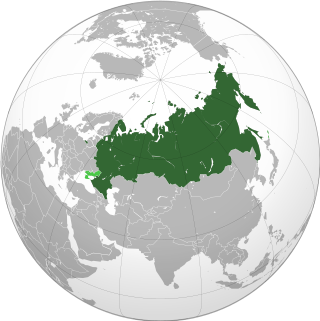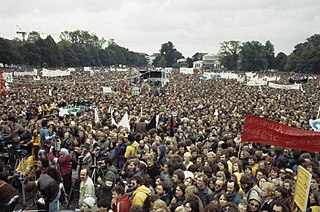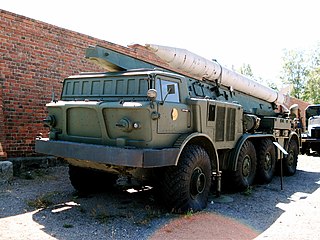
The Warsaw Pact (WP), formally the Treaty of Friendship, Cooperation and Mutual Assistance (TFCMA), was a collective defense treaty signed in Warsaw, Poland, between the Soviet Union and seven other Eastern Bloc socialist republics of Central and Eastern Europe in May 1955, during the Cold War. The term "Warsaw Pact" commonly refers to both the treaty itself and its resultant defensive alliance, the Warsaw Treaty Organization (WTO). The Warsaw Pact was the military and economic complement to the Council for Mutual Economic Assistance (Comecon), the regional economic organization for the Eastern Bloc states of Central and Eastern Europe.

World War III, World War 3, WWIII, WW3, or the Third World War are the names given to a hypothetical global conflict subsequent to World War I and World War II. The term has been in use since as early as 1941. Some apply it loosely to limited or more minor conflicts such as the Cold War or the war on terror. In contrast, others assume that such a conflict would surpass prior world wars in both scope and destructive impact.

The Intermediate-Range Nuclear Forces Treaty was an arms control treaty between the United States and the Soviet Union. US President Ronald Reagan and Soviet General Secretary Mikhail Gorbachev signed the treaty on 8 December 1987. The US Senate approved the treaty on 27 May 1988, and Reagan and Gorbachev ratified it on 1 June 1988.

The RSD-10 Pioneer was an intermediate-range ballistic missile with a nuclear warhead, deployed by the Soviet Union from 1976 to 1988. It carried GRAU designation 15Ж45 (15Zh45). Its NATO reporting name was SS-20 Saber.

The Russian Federation is known to possess or have possessed three types of weapons of mass destruction: nuclear weapons, biological weapons, and chemical weapons. It is one of the five nuclear-weapon states recognized under the Treaty on the Non-Proliferation of Nuclear Weapons.

The United States is known to have possessed three types of weapons of mass destruction: nuclear, chemical, and biological weapons. The U.S. is the only country to have used nuclear weapons on another country, when it detonated two atomic bombs over two Japanese cities of Hiroshima and Nagasaki during World War II. It had secretly developed the earliest form of the atomic weapon during the 1940s under the title "Manhattan Project". The United States pioneered the development of both the nuclear fission and hydrogen bombs. It was the world's first and only nuclear power for four years, from 1945 until 1949, when the Soviet Union produced its own nuclear weapon. The United States has the second-largest number of nuclear weapons in the world, after the Russian Federation.

Canada has not officially maintained and possessed weapons of mass destruction since 1984 and, as of 1998, has signed treaties repudiating possession of them. Canada ratified the Geneva Protocol in 1930 and the Nuclear Non-proliferation Treaty in 1970.

The Treaty on the Final Settlement with Respect to Germany , or the Two Plus Four Agreement , is an international agreement that allowed the reunification of Germany in the early 1990s. It was negotiated in 1990 between the 'two', the Federal Republic of Germany and the German Democratic Republic, in addition to the Four Powers which had occupied Germany at the end of World War II in Europe: France, the Soviet Union, the United Kingdom, and the United States. The treaty supplanted the 1945 Potsdam Agreement: in it, the Four Powers renounced all rights they had held with regard to Germany, allowing for its reunification as a fully sovereign state the following year. Additionally, the two German states agreed to reconfirm the existing border with Poland, accepting that German territory post-reunification would consist only of what was presently administered by West and East Germany—renouncing explicitly any possible claims to the former eastern territories of Germany including East Prussia, most of Silesia, as well as the eastern parts of Brandenburg and Pomerania.
The original Treaty on Conventional Armed Forces in Europe (CFE) was negotiated and concluded during the last years of the Cold War and established comprehensive limits on key categories of conventional military equipment in Europe and mandated the destruction of excess weaponry. The treaty proposed equal limits for the two "groups of states-parties", the North Atlantic Treaty Organization (NATO) and the Warsaw Pact. In 2007, Russia "suspended" its participation in the treaty, and on 10 March 2015, citing NATO's alleged de facto breach of the Treaty, Russia formally announced it was "completely" halting its participation in it as of the next day. On 7 November 2023, Russia withdrew from the treaty, and in response the United States and its NATO allies suspended their participation in the treaty.

The OTR-23 Oka was a mobile theatre ballistic missile deployed by the Soviet Union near the end of the Cold War to replace the obsolete SS-1C 'Scud B'. It carried the GRAU index 9K714 and was assigned the NATO reporting name SS-23 Spider. The introduction of the Oka significantly strengthened Soviet theatre nuclear capabilities as its range and accuracy allowed it not only to strike hardened NATO targets such as airfields, nuclear delivery systems, and command centers, but moving targets as well. It also had a fast reaction time, being able to fire in approximately five minutes, and was nearly impossible to intercept, thereby allowing it to penetrate defenses.

Although Germany has the technical capability to produce weapons of mass destruction (WMD), since World War II it has refrained from producing those weapons. However, Germany participates in the NATO nuclear weapons sharing arrangements and trains for delivering United States nuclear weapons. Officially, 20 US-nuclear weapons are stationed in Büchel, Germany. It could be more or fewer, but the exact number of the weapons is a state secret.

OTR-21 Tochka is a Soviet tactical ballistic missile. Its GRAU designation is 9K79; its NATO reporting name is SS-21 Scarab. One missile is transported per 9P129 vehicle and raised prior to launch. It uses an inertial guidance system.

Seven Days to the River Rhine was a top-secret military simulation exercise developed at least since 1964 by the Warsaw Pact. It depicted the Soviet Bloc's vision of a seven-day nuclear war between NATO and Warsaw Pact forces.
The Rapacki Plan was a proposal presented in a speech by Polish Foreign Minister Adam Rapacki to the United Nations General Assembly on 2 October 1957 as a limited plan for nuclear disarmament and demilitarization in Central Europe by establishing a nuclear-free zone. The plan declared that the People's Republic of Poland would not station or produce any nuclear armaments within their territory, if the Federal Republic of Germany and the German Democratic Republic agreed to do the same. Czechoslovakia would later include itself in support of the nuclear-free zone. The plan followed attempts by both Western Powers and the Soviet Union to de-escalate Cold War tensions and push for greater disarmament during the mid 1950s.

The Cold War from 1979 to 1985 was a late phase of the Cold War marked by a sharp increase in hostility between the Soviet Union and the West. It arose from a strong denunciation of the Soviet invasion of Afghanistan in December 1979. With the election of Prime Minister Margaret Thatcher in 1979, and American President Ronald Reagan in 1980, a corresponding change in Western foreign policy approach toward the Soviet Union was marked by the rejection of détente in favor of the Reagan Doctrine policy of rollback, with the stated goal of dissolving Soviet influence in Soviet Bloc countries. During this time, the threat of nuclear war had reached new heights not seen since the Cuban Missile Crisis of 1962.

The NATO Double-Track Decision was the decision by NATO from December 12, 1979, to offer the Warsaw Pact a mutual limitation of medium-range ballistic missiles and intermediate-range ballistic missiles. It was combined with a threat by NATO to deploy more medium-range nuclear weapons in Western Europe after the Euromissile Crisis.

The 9K52 Luna-M is a Soviet short-range artillery rocket system which fires unguided and spin-stabilized 9M21 rockets. It was originally developed in the 1960s to provide divisional artillery support using tactical nuclear weapons but gradually modified for conventional use. The 9K52 was eventually succeeded by the OTR-21 Tochka.
Podborsko is a village in the administrative district of Gmina Tychowo, within Białogard County, West Pomeranian Voivodeship, in north-western Poland. It lies approximately 9 kilometres (6 mi) west of Tychowo, 13 km (8 mi) southeast of Białogard, and 118 km (73 mi) northeast of the regional capital Szczecin.

The Washington Summit of 1990, also known as the "Two Plus Four" talks, was an international summit in the history of the Cold War in which the United States and Germany gained the Soviet Union's support for the reunification of Germany by agreeing that NATO needed to be reformed. As part of this effort, US President George H. W. Bush called for a NATO summit to reform the organization and demonstrate NATO's willingness to present a different approach to the Soviet Union. As part of his efforts to improve relations between the United States and the Soviet Union, Bush proposed a bilateral summit in Washington to Soviet Union President Mikhail Gorbachev, in addition to the NATO summit. Gorbachev agreed to the proposal, which resulted in the Washington Summit of 1990.
















